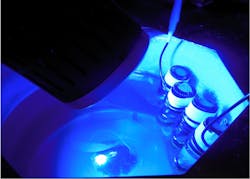Blue LEDs activate copper-based catalyst for more sustainable photochemical reactions
A group of researchers at Hokkaido University’s Institute for Chemical Reaction Design and Discovery in Japan combined blue light-emitting diodes (LEDs) with a copper-based molecular catalyst to create a more sustainable way to make chemical subunits (single molecules that assemble with others to form a complex)—with potential applications in pharmaceutical and photoelectronic development.
The blue LED and copper-based molecular catalyst combo generates a cross-coupling reaction, in which two molecules are joined via a carbon-carbon bond. It’s a widely used type of reaction essential for creating the majority of chemical products today.
Using copper, which is a cheap and commonly available metal, as the catalyst for the cross-coupling reaction is a big deal for sustainability because precious metals like palladium tend to be used today for these reactions.
“The key basic concept here is the direct photoexcitation of a copper catalyst,” says Masaya Sawamura, a chemistry professor. “Conventional photochemical reactions require the use of harmful ultraviolet (UV) light or expensive precious metal catalysts to help with light absorption. The method we’ve developed is innovative in that the inexpensive copper catalyst directly absorbs visible light, which promotes the chemical reaction directly.”
Surprisingly, he adds, it turned out that this reaction involves two photochemical processes within a single catalytic chemical reaction. “One is the known photochemical process that converts the starting organic molecule into another molecule, which is activated by a ground-state copper catalyst,” explains Sawamura. “The other was an unexpected photoexcitation of the resulting catalytic organocopper intermediate. This two-step photochemical reaction enables an unprecedented molecular transformation.”
The group’s theoretical calculations show that the blue light exposure causes electrons to move from the metal copper atom to a connected subunit of the molecular catalyst. This excited state has separated electrical charges, they report, which makes the catalyst much more reactive. And they were able to use it to carry out a cross-coupling reaction to create an acyl group, which are useful for the synthesis of pharmaceuticals and photoelectronic materials.
Since copper within the molecular catalyst itself absorbs the blue light, rather than requiring a separate light-absorbing compound in addition to the catalyst, there are fewer moving parts. This makes the synthesis cheaper and simpler to perform and control.
Both blue LEDs and the copper catalyst are readily available, Sawamura points out, so this reaction is applicable to sustainable synthesis of pharmaceuticals and other products. “We hope our research will stimulate an innovative development of synthetic organic chemistry, which has largely relied on precious resources,” he says.
The group is now working on developing new reactions based on photoexcitation of copper catalysts. “New exciting findings have already been obtained and will be reported in the near future,” Sawamura says.
REFERENCE
1. Y. Ueda et al., J. Am. Chem. Soc. (Jan. 6, 2022); https://pubs.acs.org/doi/10.1021/jacs.1c11526.

Sally Cole Johnson | Editor in Chief
Sally Cole Johnson, Laser Focus World’s editor in chief, is a science and technology journalist who specializes in physics and semiconductors. She wrote for the American Institute of Physics for more than 15 years, complexity for the Santa Fe Institute, and theoretical physics and neuroscience for the Kavli Foundation.
